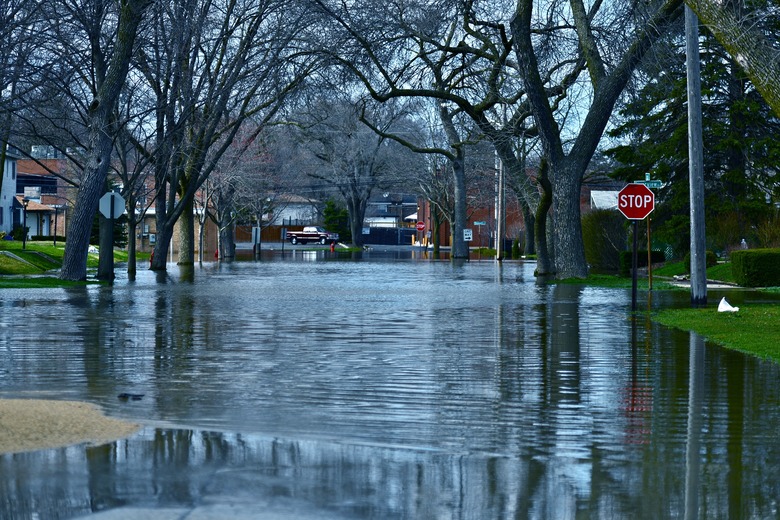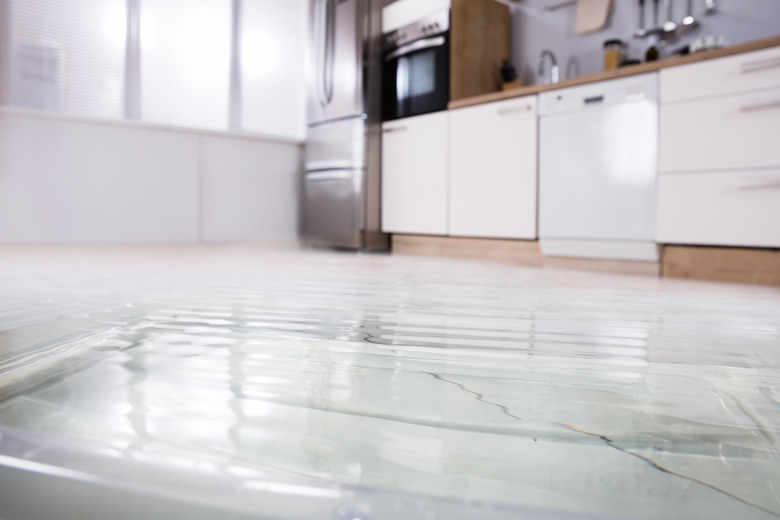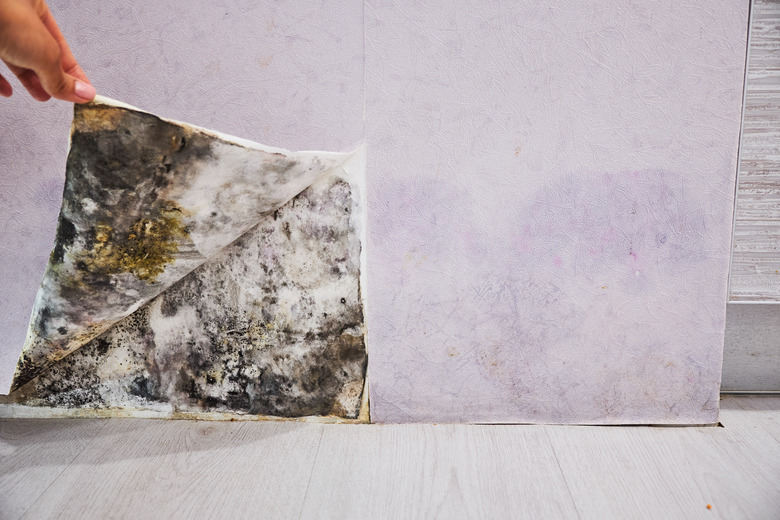The First 8 Things You Need To Do After Your Home Has Been Damaged In A Flood
We may receive a commission on purchases made from links.
When you've had to leave your home after a flood, you'll want life to get back to normal as soon as possible — but in order to do that you'll need to remove the remaining standing water and address the resulting water damage in every area of the house first. Because floodwater tends to be dirty, most of your porous materials that have absorbed the contaminated water, including mattresses, drywall and carpeting, will have to be completely removed and replaced. If you start replacing the materials too soon, though, your home may not have a chance to fully dry, which can result in further damage, such as mold and mildew contamination and moisture problems in your new replacement materials.
Beyond removing water damage from your home, you'll also need to ensure that your home is safe enough to enter and that the proper documentation is done so that you can file an insurance claim.
1. Make the Area Safe
1. Make the Area Safe
Before reentering your flooded home, always take measures to protect your own safety. First, inspect the area from the outside to identify any potentially dangerous structural damage before entering. If you believe any floodwater in the area is coming from your own broken pipes, turn off your home's water supply at the main shutoff valve.
Look for any obvious damage to your electrical systems or gas lines that could present a safety hazard. If you smell gas, do not enter the home. Move well away from the house and call the gas company or fire department. Do not return to the area until it has been cleared by a professional.
Remember that water is highly conductive, meaning moisture located around a source of live electricity is a serious shock hazard. If you can reach your home's service panel (breaker box) or outdoor disconnect switch, turn off the power. If you must enter standing water in order to access the panel, call an electrician to disconnect the power. Do not enter an area filled with standing water until the power has been shut off.
Hire an electrician to check your home's electrical systems before turning the power back on again. Only use battery-powered light sources until an electrician has cleared your home and restored the power. Do not use a gas-powered generator or any other gasoline-powered machinery indoors.
2. Keep Yourself Safe
2. Keep Yourself Safe
Wear personal protective equipment when entering the flooded area. Wear sturdy, nonslip rubber boots, rubber gloves, eye protection, long sleeves, long pants and a respirator. When the standing water has been removed, you can wear sturdy, nonslip shoes or boots rather than rubber boots.
Creatures may enter structures during floods, so keep an eye out for wild animals, particularly fire ants and snakes. If the area was closed up for a few days or more, open the windows when you first enter and leave the flood zone for at least 30 minutes to allow it to air out. This will reduce contaminants in the air and give stray animals a chance to escape.
If your home contains asbestos insulation or tiles, be sure to hire professionals to remove these materials.
3. File an Insurance Claim
3. File an Insurance Claim
House floods are not covered by most standard homeowners' insurance policies unless they are caused by sudden water damage not related to a natural disaster — for example, damage resulting from a broken pipe. If you have a flood insurance policy, you'll want to prepare to file a claim with your insurer. Start by calling your insurance company immediately to notify it of the situation.
Next, document all of the damages by taking pictures and/or videos. This should be sufficient to show your insurance adjuster what occurred. Do not wait for the adjuster to arrive before beginning the cleanup process or your home may suffer further water damage. As you clean and make repairs, keep the damaged materials in a space outside of the home and document the costs for all repair supplies. The adjuster will use all of this information to assess the damage and create a proof of loss statement as part of your insurance claim.
If you do not have an insurance policy that covers loss due to flood, you may apply for federal assistance through the Federal Emergency Management Agency if the flood was declared a federal disaster. Keep in mind that this program is not the same as insurance and you will not be reimbursed for all of your losses.
4. Remove the Standing Water
4. Remove the Standing Water
If your electricity has been restored, use a wet-dry shop vacuum, water transfer pump or sump pump to remove the standing water right away . If your power has not been restored, you can use a portable generator to power one of these devices. Pump out the water in stages, removing no more than a third of the water per day to ensure excessive water is not left in your yard. If you pump too much too quickly, this could result in too much pressure accumulating in the soil around your home, which could cause the walls of your basement to collapse. You can also contact a flood restoration service to remove the water and address any potential mold problems if you're not comfortable doing these tasks yourself.
If it's reasonably warm and dry outside, open your windows and doors to help dry out the inside of your home. Place fans near the doors and windows of the flooded area, making sure they're blowing air out rather than inside the space. You can also use a dehumidifier to help pull additional moisture from the air.
Lastly, make sure more water can't enter your home if there are more heavy rains to come. Check that gutter downspouts are correctly draining away from the house and that the ground near your home slopes away from the structure. Look to see if your crawl space has good drainage to minimize water seepage and then ventilate this area so it can dry.
5. Evaluate What Can Be Saved
5. Evaluate What Can Be Saved
Once the standing water has been removed, the cleanup process can really begin. Start by removing your furniture, clothing, bedding and carpeting to determine what can be cleaned and dried and what needs to be thrown away. Rugs, carpets and carpet pads usually need to be replaced, but if they have been exposed to a minimal amount of water for a short amount of time, they can be hosed off and cleaned with a carpet shampoo and broom or sent to a professional cleaner. Allow the carpet and subfloor to dry thoroughly before reinstalling. If carpet has shrunk after cleaning, a carpet repair service may be able to stretch it.
Upholstered furniture and mattresses that have been exposed to floodwater should be replaced, but for particularly valuable furniture items, it may be possible to salvage the piece if the stuffing and upholstering is replaced. Wood, metal and plastic furniture can usually be salvaged by cleaning, sanitizing and allowing these pieces to dry fully in an area outside of direct sun, which could cause warping.
Items that have absorbed water and can't be disinfected need to be discarded, including cosmetics, paper products, stuffed animals and pillows. Clothing can usually be cleaned, but some items, such as furs and silks, may be destroyed for good. Remove any electrical appliances, such as your dryer and washing machine, and then clean them and have them evaluated by an electrician before use. Remember to hold on to items that you are replacing until the insurance adjuster arrives.
6. Address Damage in the Kitchen
6. Address Damage in the Kitchen
In a flood, your local water supply may be contaminated, and unless you have been told it is clean, use bottled or purified water for drinking, cooking, personal sanitation and cleaning dishes or food products. You can sterilize water by filtering it with a clean cloth and then boiling it vigorously for a full minute or by adding eight drops of unscented chlorine bleach to 1 gallon of clear water or 16 drops of bleach to 1 gallon of cloudy water. If your water comes from a private well, have it tested and cleared for consumption before use.
Foods in undamaged metal cans may still be salvageable even if they were in the flood, but all other food and medicinal products that may have been in contact with the water need to be destroyed. For canned foods you intend to salvage, remove the labels, wash the cans and disinfect them with a sterilizing bleach solution made from 1 tablespoon of bleach per gallon of clean water. Draw on new labels with a marker, taking care to include any applicable expiration dates. Also discard any food that was not refrigerated properly due to a power outage, anything that spoiled while you were away from home and anything that smells, looks or feels off. Be sure to throw away any food or medicines if you aren't 100 percent certain that they're safe.
Throw away any porous dishes or utensils, such as those made from plastic or wood. Wash pans, dishes and utensils made from metal, ceramic or glass with hot, soapy water and sanitize them by soaking them in a solution made from 1 teaspoon of bleach per quart of clean water.
7. Fix the Home Interior
7. Fix the Home Interior
Once you've removed any items in the home, it's time to move on to the home itself. Remove and dispose of all ceiling tiles, baseboards, insulation and drywall located up to 4 feet above the flood line. Remember that these materials absorb water, so they do not need to have directly touched the water to be contaminated by it. Undamaged paneling should still be removed to speed up the drying process, but it can be reinstalled again later.
Clean out the mud in the walls. Spray the wall studs and plates with a disinfectant made with 1 cup of bleach to 1 gallon of water to kill any pathogens, such as mold and fungi. Leave the walls open until they are completely dry or you may risk further damage. Be aware that the drying process could take up to a month.
Sanitize anything touched by any amount of water in the flood, even if you suspect it may have just been splashed by the contaminated water. This includes cabinets, counters and more. Clean with soap and water first and then disinfect with a solution made from 1/4 cup of bleach per cup of water.
Sheet flooring or tile on damaged subfloors will need to be removed. If the flooring is damaged, removing it will speed up the drying process, but if your flooring material is unharmed and removal could damage the flooring, you might want to avoid removing it. For wood floors, remove a board every few feet to prevent problems associated with swelling. You may need to hire a carpenter or flooring expert to remove the boards without causing damage. Clean and sanitize the floor and then wait until it is thoroughly dry before repairing any damage or replacing the missing boards.
8. Address Mold Problems
8. Address Mold Problems
Mold begins growing between 24 and 48 hours of water exposure and continues to grow as long as there is moisture around. If you fail to kill the mold and fully dry your home before repairing and replacing the damage, then mold can continue to breed, causing harm to yourself and your home. If you notice mold, hiring a professional mold abatement company might be the best option to ensure it is fully destroyed, especially if the mold problem is particularly severe, if you're not very comfortable with home improvement projects or if you have allergies or immune system issues.
Even if you do most of the mold abatement yourself, have an expert in heating, ventilating and air conditioning systems (HVAC) check on your system before you use it. If your HVAC system was exposed to water during the flood, it could be contaminated with mold, and turning it on will spread mold spores throughout your home. If it does have mold in it, professional cleaners can eliminate the problem.
When you begin the flood cleanup process, take the time to clean moldy and mildewed items outside to avoid spreading spores. Use a bagged vacuum with a HEPA filter to remove mold spores and discard the bag after use, and dry items in the sun when possible unless the sun itself may damage the items. Clean remaining mildew on products with a commercial cleaning product made for the specific type of material and then wipe with a clean, lightly damp cloth.
Mold and mildew abatement is a lengthy process, so continue attempting to dry out your home for the next few months following the flood. Once the HVAC system has been cleared as safe for use, the air conditioner can be used continuously to help remove extra moisture from the home. Until your HVAC system is cleared for use or if you do not have air conditioning, leave your windows and doors open and circulate air with fans as much as possible when the weather permits. Even turn on the lights in closets and leave closet and cabinet doors open to speed drying. Finally, be sure to use exhaust fans when cooking and while showering or bathing to avoid adding moisture to the home.


